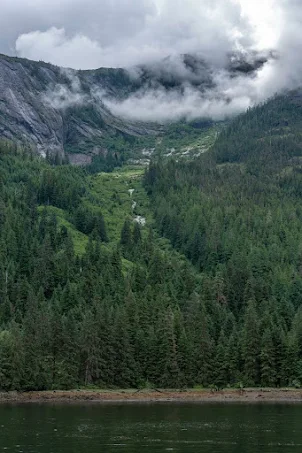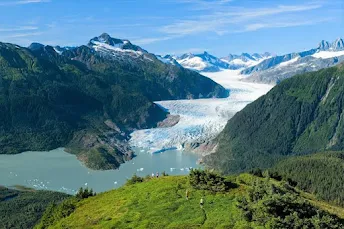Tongass National Forest: The Crown Jewel of Alaska’s Wilderness
Introduction
Nestled in the southeastern region of Alaska, Tongass National Forest is the largest national forest in the United States, covering approximately 16.7 million acres. A vast and breathtaking expanse of old-growth temperate rainforest, glacier-fed rivers, and rugged coastline, it is often referred to as the “lungs of North America” due to its ability to store massive amounts of carbon.
Tongass is home to a rich diversity of wildlife, indigenous cultures, and some of the most stunning landscapes on Earth. It serves as a sanctuary for grizzly bears, bald eagles, Sitka black-tailed deer, wolves, and countless salmon species that thrive in its pristine rivers.
For wildlife photographers, adventure seekers, and conservationists, Tongass National Forest offers an unparalleled opportunity to experience the raw, untouched beauty of Alaska. This article explores the biodiversity, indigenous heritage, conservation efforts, and ways to explore Tongass while respecting its delicate ecosystem.
A Land of Giants: The Ancient Ecosystem of Tongass
Old-Growth Rainforest
Tongass is a temperate rainforest, meaning it experiences high levels of rainfall (over 150 inches per year), supporting a lush ecosystem of towering Sitka spruce, western hemlock, and red cedar trees—some of which are over 1,000 years old. These ancient trees play a crucial role in absorbing carbon dioxide, preventing erosion, and providing habitat for countless species.
Walking through Tongass feels like stepping back in time, with moss-covered trees, misty fjords, and the sounds of wildlife echoing through the forest.
Rivers of Life: The Salmon Connection
One of the most vital elements of Tongass is its salmon population. The forest’s rivers and streams serve as critical spawning grounds for all five species of Pacific salmon—Chinook, Sockeye, Coho, Pink, and Chum. These fish are not only crucial to the local ecosystem but also sustain indigenous communities, commercial fisheries, and predators like bears and eagles.
Each year, millions of salmon return to their spawning grounds, creating a natural cycle of renewal that feeds the land and the wildlife. Photographers and wildlife lovers flock to Tongass during salmon runs (July-September) to capture dramatic scenes of bears fishing in rushing waterfalls.
Wildlife of Tongass: A Photographer’s Paradise
1. Grizzly Bears and Black Bears
Tongass is one of the best places in the world to see wild bears. Both grizzly (brown) bears and black bears roam the forests, with some of the highest bear densities in North America.
Photography Tips for Capturing Bears:
- The best time to photograph bears is during salmon runs (mid-summer to early fall) when they gather near rivers to feed.
- Anan Creek Wildlife Observatory and Pack Creek Bear Viewing Area are prime bear-watching spots.
- Use a telephoto lens (400mm or more) to maintain a safe and respectful distance.
- Golden-hour lighting (early morning or late evening) enhances fur textures and natural contrasts.
2. Bald Eagles: America’s National Bird
Tongass is home to the largest concentration of bald eagles in the world. These majestic raptors are often seen perched in tall trees or soaring above rivers in search of fish.
Photography Tips for Capturing Eagles:
- Use a fast shutter speed (1/2000s) to freeze eagles in flight.
- Look for them near salmon streams during peak fishing seasons.
- A tripod and telephoto lens (300-600mm) help capture crisp details.
3. Wolves: The Ghosts of the Forest
The Alexander Archipelago wolf, a rare subspecies of gray wolf, is native to the region. Though difficult to spot, they are often heard howling deep within the forest.
Photography Tips for Capturing Wolves:
- Visit remote islands and coastal areas where wolf packs roam.
- Use trail cameras or long-exposure techniques for low-light conditions.
- Stay patient—wolves are elusive and tend to avoid human presence.
4. Marine Wildlife: Whales, Sea Lions, and Otters
Tongass extends into the Alexander Archipelago, where humpback whales, orcas, sea otters, and Steller sea lions thrive.
Photography Tips for Marine Wildlife:
- Take a boat tour from Sitka, Juneau, or Ketchikan for whale-watching.
- Use a polarizing filter to reduce glare on water.
- Capture breaches and tail slaps by using a fast shutter speed (1/1000s).
Indigenous Culture and Heritage
Tlingit, Haida, and Tsimshian Peoples
For thousands of years, the Tlingit, Haida, and Tsimshian people have called Tongass home, living in harmony with the land and sea. Their deep-rooted culture is reflected in intricate totem poles, traditional canoe journeys, and rich storytelling traditions.
Experiencing Indigenous Culture
- Visit Totem Bight State Park (Ketchikan) to see beautifully carved totem poles.
- Explore the Sealaska Heritage Institute (Juneau) to learn about native traditions.
- Attend a cultural festival or guided tour with indigenous elders.
Conservation Efforts and Threats
1. Logging and Deforestation
- Historically, large-scale logging threatened Tongass’ old-growth forests.
- In 2021, the U.S. government reinstated protections, banning logging in much of the forest.
- Conservationists continue to advocate for stronger protections against commercial deforestation.
2. Climate Change and Melting Glaciers
- Rising temperatures threaten salmon populations and disrupt wildlife migration patterns.
- Coastal erosion and changing ocean currents affect marine species.
3. Eco-Tourism as a Solution
- Sustainable tourism helps fund conservation while providing economic alternatives to logging.
- Ethical wildlife viewing tours minimize human impact on fragile ecosystems.
How to Explore Tongass National Forest
1. Best Time to Visit
- Summer (June-August): Best for bear-watching, whale-watching, and salmon runs.
- Fall (September-October): Stunning autumn colors and quieter trails.
- Winter (December-February): Snow-covered landscapes and northern lights.
2. Best Ways to Explore
- Hiking Trails: Mendenhall Glacier Trail, West Glacier Trail, and Ward Lake Trail.
- Kayaking & Canoeing: Paddle through Misty Fjords National Monument for breathtaking scenery.
- Wildlife Boat Tours: Departing from Sitka, Ketchikan, or Juneau.
Conclusion: Why Tongass Matters
Tongass National Forest is more than just a breathtaking landscape—it is a vital ecosystem, a cultural treasure, and a haven for wildlife. Whether you're capturing the power of a breaching whale, photographing a grizzly fishing in the river, or standing in awe beneath towering ancient trees, Tongass offers an experience unlike any other.
For wildlife photographers and nature lovers, protecting this last great temperate rainforest is crucial. By visiting responsibly, supporting conservation efforts, and respecting indigenous heritage, we can ensure that Tongass remains wild and beautiful for generations to come.








0 Comments